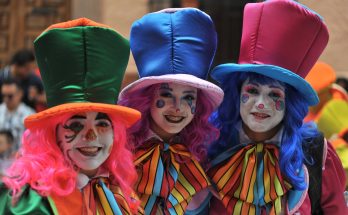Photo By Arturo Suárez
By Graciela Cruz López
Of recognized cultural value, religious symbolism, collective imaginary and historical transcendence, is the traditional visit of the Lord of the Column, a light sculpture manufactured between 1750 and 1775 in colorín wood (carved and polychrome), made of papelón and glued fabrics. Apparently of unknown author, although the oral tradition has attributed it to the Oratorian priest Remigio Angel Gonzalez, chaplain of Atotonilco in the first decade of the XIX century.
The Lord of the Column, patron of the Precious Blood of Christ, of deep spirituality and deep-rooted devotion, among the guardians and brotherhoods of all the directions that converge in the House of Spiritual Exercises of Jesus Nazarene of Atotonilco, of the towns that surround the road from San Miguel to Atotonilco, from the neighborhood of San Juan de Dios and the San Miguel community living in the urban demarcation, in its rural communities and neighborhoods, has been transferred from the Sanctuary of Atotonilco to the city of San Miguel de Allende by the faithful and their brotherhood, honoring the collective memory, uninterruptedly since the year 1823.
This manifestation of religiosity, piety and popular tradition, which has formed a pilgrimage on the old route of the Camino Real de la Tierra Adentro, and processional circuit from what was the fifth entrance and exit that made «camino real para afuera» (Independencia Avenue – Santa Ana or Insurgentes Street) and the main streets of the neighborhood near the Hospital Real de San Rafael and San Juan de Dios, keeps the tangible and intangible, historical, spiritual and symbolic relationship between San Miguel de Allende and Atotonilco valid until the present.
From April of 1919, comes one of the original documentary sources that have been located, and that denotes the persistence and defense of the tradition and visit of the Lord of the Column, even when the social conditions were not ideal, due to the instability caused by the revolutionary movements and the epidemic outbreaks of influenza or Spanish flu and bubonic plague:
Permission is granted to Messrs. Reyes Cadena, Crescencio Rios and Rosalio Guzman, to bring Mr. de la Columna, from Atotonilco to this city.
J. Reyes Cadena, Crescencio Ríos and Rosalío Guzmán to transport the image of the Sr. de la Columna, from Atotonilco to this city, to the Yglesia de San Juan de Dios, next Thursday afternoon, calculating that it will arrive here at 8:08 p.m.; making the same Messrs. Reyes Cadena, Crescencio Ríos and Rosalío Guzmán responsible for this to have the due reserve, so that there will be no agglomeration of people, nor that it has the character of a procession. That the image comes covered and without religious manifestation of any kind, since the permission is only for the conduction of the image from the Sanctuary of Atotonilco to this city.
San Miguel de Allende, April 10, 1919.
In the same way, another license was issued to take the image leaving from here on Thursday, April 24 at 2 o’clock in the morning.
It is probable that because of the need to maintain the reserve of the transfer, and due to the instruction to cover the image to shelter it from the weather and the eyes of the pious, this has become a tradition in subsequent years, in which it has been wrapped for its pilgrimage between silk canvases, until celebrating the ritual of the discovery, shortly before its heroic and sublime arrival in the city:
«On Saturday of the week of Lazarus, provided with lanterns, bandanas, candles, blankets and staff, at dusk, the pilgrims are on their way to Atotonilco. At the stroke of midnight, the Lord of the Column leaves the temple wrapped in blankets and silks to protect him from the rain and dust, and the 12 kilometer procession slowly begins during the night».
In contemporary times, among torches, lanterns and lamps, healing and aromatic herbs, offerings of a diversity of foods, an infinity of flowers and colorful arches, unique expressions of popular art, prayers, praises, music and passional songs, the Sunday before Palm Sunday, the Lord of the Column, guarded by 30,000 faithful, has been received in the city, year after year, by a congregation of 65,000 people strengthened in their faith, in their unwavering belief and inescapable legacy.




